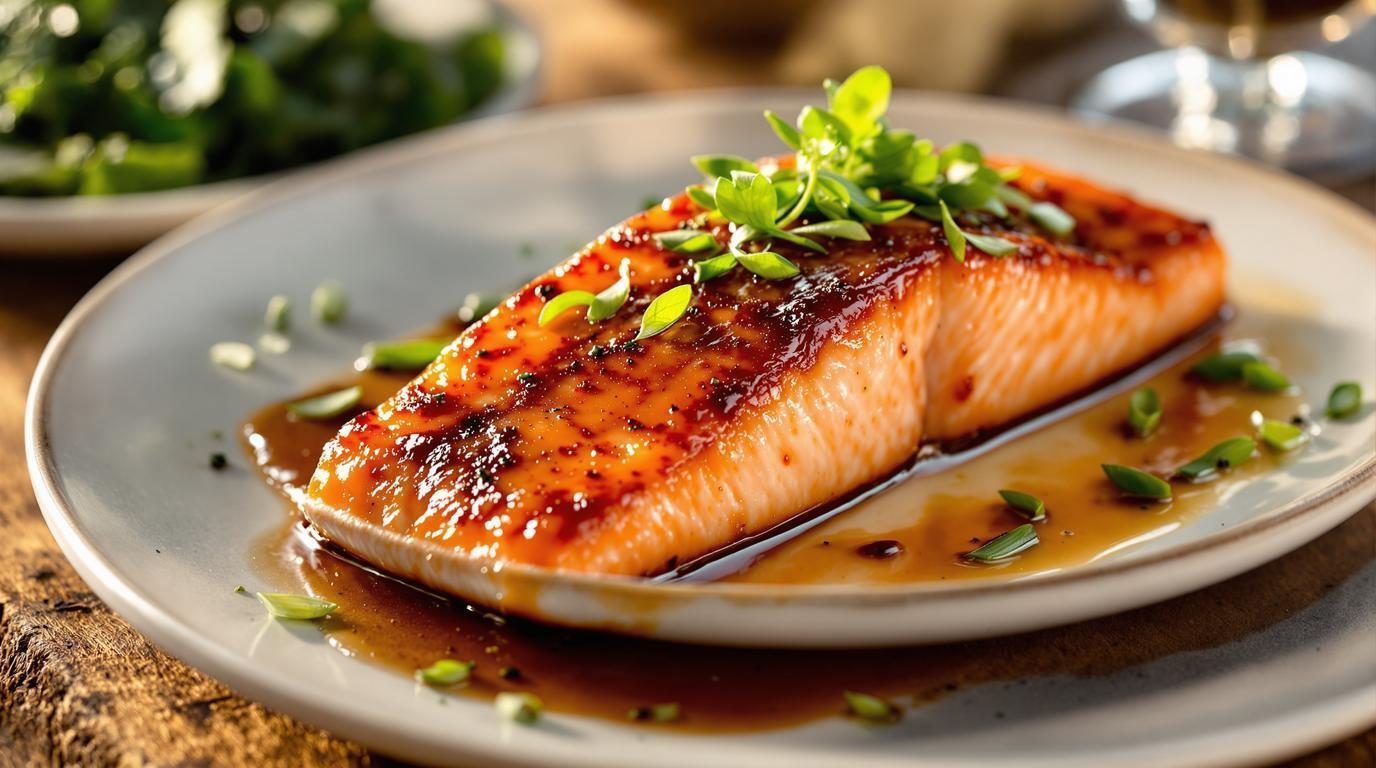There’s something almost magical about the simplicity of maple-glazed salmon. Growing up, my grandmother would make this dish on special occasions, filling our New England home with the sweet aroma of maple and the promise of a delicious meal. What I love most about this recipe is how it transforms an everyday protein into something worthy of celebration in just 20 minutes. The secret? That perfect balance between sweet maple and smoky BBQ flavors that creates a glaze that caramelizes beautifully on the salmon’s surface.
The Story Behind Maple-Glazed BBQ Salmon 📖
This recipe honors the Indigenous peoples of North America who first harvested maple sap and introduced settlers to its remarkable sweetness. I’ve added subtle BBQ notes to create a cross-regional American fusion that respects tradition while adding contemporary flair. During my years cooking in Vermont, I learned that the best maple glazes are simple—allowing the quality of both the syrup and the salmon to shine through. This is comfort food elevated to elegance.
Essential Ingredients 🧾
For 4 servings:
- 1 pound (450g) fresh salmon fillets, preferably center-cut
- ¼ cup (60ml) pure maple syrup (Grade A Dark Robust for strongest flavor)
- 2 tablespoons (30ml) low-sodium soy sauce
- 1 teaspoon garlic powder
- ½ teaspoon smoked paprika
- ¼ teaspoon freshly ground black pepper
- 2 tablespoons (30ml) olive oil
- Kosher salt, for seasoning
Chef’s Note: Don’t have maple syrup? Quality honey works beautifully, though you’ll lose some of that distinctive maple character. For gluten-free diets, substitute tamari for soy sauce. And for those who prefer fresh ingredients, one minced garlic clove can replace the powder—just be careful it doesn’t burn during the final broil.
Step-by-Step Instructions 📝
1. Prepare the salmon
Preheat your oven to 450°F (232°C). Pat the salmon fillets completely dry with paper towels—this is crucial for proper glazing and caramelization. Season lightly with kosher salt and place skin-side down in a lightly oiled baking dish. For easy cleanup, line the dish with foil first.
2. Create the maple BBQ glaze
In a small bowl, whisk together the maple syrup, soy sauce, garlic powder, smoked paprika, and black pepper until completely incorporated. The soy sauce adds that umami depth that complements the sweetness perfectly. Divide this mixture—you’ll use about ⅔ during cooking and reserve ⅓ for the final glaze.
3. Initial bake
Brush the salmon generously with about half of your glaze mixture. Bake at 450°F for 12 minutes. The salmon should be starting to cook through but not yet done.
4. Broil for the perfect finish
Switch your oven to broil. Brush the salmon with another layer of glaze, then broil for 4-5 minutes until the glaze caramelizes and turns slightly dark at the edges. Watch carefully during this step—the difference between caramelized and burnt happens quickly!
5. Rest and serve
Remove from the oven and let rest for 2 minutes. Drizzle with the remaining glaze right before serving. The internal temperature should reach 145°F (63°C).
Chef’s Secret Techniques 🤫
The two-stage glazing process is essential for developing layers of flavor. Applying all the glaze at once would result in a wet, soggy exterior rather than that beautiful caramelization we’re after. For an extra-crispy glaze hack, add 1 tablespoon of brown sugar to your final glazing mixture before broiling.
Another pro tip: never marinate salmon in this mixture for more than 20 minutes. The acid in the soy sauce can begin to “cook” the fish, resulting in a mushy texture rather than that perfect flakiness we want.
Serving & Presentation Tips 🍽️
I like to serve this salmon with complementary sides that balance the sweetness—braised kale with bacon adds a savory counterpoint, while dill roast potatoes bring an herbal freshness. For a complete meal, pair with a crisp Sauvignon Blanc or dry Riesling to cut through the richness.
Spoon any extra glaze over basmati rice or roasted vegetables on the plate. Garnish with a light sprinkle of chives or thinly sliced scallions and a wedge of lemon for brightness.
When I make this dish now, I’m transported back to my grandmother’s kitchen, watching her expertly apply that final glaze with focused precision. While she didn’t use smoked paprika, I think she’d approve of this modern twist that honors the essence of her classic recipe. It proves that sometimes the simplest techniques—when executed with care and quality ingredients—create the most memorable meals.
